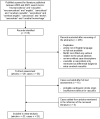Cerebral vasculitis related to neurosarcoidosis: a case series and systematic literature review
- PMID: 39812656
- PMCID: PMC11735521
- DOI: 10.1007/s00415-024-12868-2
Cerebral vasculitis related to neurosarcoidosis: a case series and systematic literature review
Abstract
Cerebral vasculitis is a rare but severe manifestation of neurosarcoidosis (NS) that has received little attention. The aim of the present study was to characterize clinical and diagnostic features as well as potential treatment strategies of cerebral vasculitis related to NS. We assessed 29 patients with cerebral vasculitis related to NS (15 female, mean age at time of diagnosis 45 years, SD = 11.85) among these were four new cases from our hospital records and 25 previously published cases from a systematic literature review. The demographic, clinical, and diagnostic features of those 29 patients with cerebral vasculitis related to NS were compared with a group of 73 NS patients without vasculitic involvement (37 female, mean age at time of diagnosis 47 years, SD = 14.79). Neurologic deficits and MRI abnormalities were significantly more frequent in cerebral vasculitis related to NS than in NS without vasculitic involvement. Patients with cerebral vasculitis related to NS significantly more often presented with headache, motor symptoms, and cognitive and/or behavioral changes. Non-neurologic manifestations of sarcoidosis did not significantly differ in character or frequency between both groups. Glucocorticoids in combination with methotrexate, cyclophosphamide, or infliximab were the most frequently used treatment strategies in cerebral vasculitis related to NS. Within the complex diagnostic work-up that is required in cerebral vasculitis related to NS sufficient angiographic imaging as digital subtraction angiography or MRI vessel wall imaging and tissue biopsy are of particular significance as they can detect vascular changes caused by inflammatory processes.
Keywords: Cerebral ischemia; Intracranial hemorrhage; Neurosarcoidosis; Sarcoidosis; Stroke; Vasculitis.
© 2025. The Author(s).
Conflict of interest statement
Declarations. Conflicts of interest: Roland Veltkamp reports grants from Boehringer Ingelheim; grants from Medtronic; grants from Daiichi Sankyo Company; compensation from Portola Pharmaceuticals for end point review committee services; compensation from Bristol Myers Squibb for consultant services; grants from Bayer; grants from Bristol Myers Squibb; compensation from Daiichi Sankyo Company for consultant services; compensation from AstraZeneca for consultant services; and compensation from Javelin Ventures for consultant services. All other authors report no conflicts. Ethical approval: Due to its retrospective nature this study was conducted only on already existing data. The study was conducted in accordance with local ethical requirements.
Figures


References
Publication types
MeSH terms
Supplementary concepts
LinkOut - more resources
Full Text Sources
Medical
Miscellaneous

